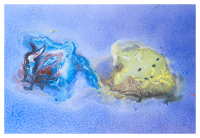Speaker
Ralf W. Gothe
(University of South Carolina)
Description
Meson-photoproduction measurements and their reaction-amplitude analyses can establish more sensitively, and in some cases in an almost model-independent way, the nucleon excitations and non-resonant reaction amplitudes. However, to investigate the strong interaction from explored – where meson-cloud degrees of freedom contribute substantially to the baryon structure – to still unexplored distance scales – where quark degrees of freedom dominate and the transition from dressed to current quarks occurs – we depend on experiments that allow us to measure observables that are probing this evolving non-perturbative QCD regime over its full range.
Transition form factors are uniquely suited to trace this evolution by measuring exclusive single-meson and double-pion electroproduction cross sections off the free proton. Recent efforts try to include their isospin dependence by analyzing the cross sections off the quasi-free neutron and proton in Deuterium. In the near future, these exclusive measurements will be extended to higher momentum transfers with the energy-upgraded CEBAF beam at JLab to study the quark degrees of freedom, where their strong interaction is responsible for the ground and excited nucleon state formations. After establishing unprecedented high-precision data, the imminent next challenge is a high-quality analysis to extract these relevant electrocoupling parameters for various resonances that then can be compared to state-of-the-art models and QCD-based calculations. Recent results will demonstrate the status of the analysis and of their theoretical descriptions, and an experimental and theoretical outlook will highlight what shall and may be achieved in the new era of the 12-GeV upgraded transition form factor program.
Author
Ralf W. Gothe
(University of South Carolina)
Co-author
Viktor I. Mokeev
(Jefferson Lab)
